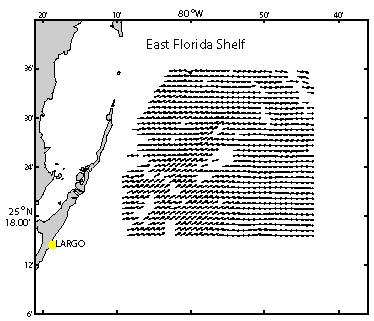Wind is not directly measured by HF radar; instead it is inferred from the Bragg resonant gravity waves, which are assumed to be locally generated by the wind field. The functional relationship between the wind and wave directions has been a central research issue. If the seas are fully developed, the wave field is in equilibrium with the wind and is not limited by fetch or duration and the relationship can be modeled relating the wave distribution to the wind direction.
Wave direction is estimated from the relative amplitudes of the two first-order Bragg peaks, known as the Bragg line ratio. Waves travelling towards or away from the radar will produce a large Bragg line ratio (due to predominantly approaching waves and almost no receding waves or vice versa) and waves travelling across the radar look direction will produce a small ratio. Long & Trizna [1973] noted that the universal existence of the weaker of the two Bragg peaks indicates that there is a non-zero component of sea roughness at angles greater than ±90° to the wind direction which is responsible for the scatter. If the form of the waves’ directional spreading function is known, the angle of the wind from a radar radial can be determined [Harlan & Georges, 1994]. With a single HF radar measurement there is a directional ambiguity as the radar cannot distinguish between left and right and this must be solved with additional information; using either independent observations or a second radar site viewing the ocean from a different angle.
Wind speed measurements by HF radar are still under investigation. With increasing wind speed the energy of the Bragg scattering waves increases less and less and will eventually reach saturation [Barale & Gade, 2008]. Instead of a further increase in wave height, the energy is transferred into longer ocean waves by nonlinear wave-wave interaction. Thus using the relative amplitude of the first order Bragg peaks is insufficient and the complete ocean wave spectrum must be utilized.

A new technique for measurements of wind direction was developed by Lucy Wyatt, by measuring the directional spectrum of high-frequency ocean wave using HF radar (Wyatt L.R., L.J. Ledgard,C.W. Anderson, 1997. “Maximum likelihood estimation of the directional distribution of 0.53Hz ocean waves.” Journal of Atmospheric and Oceanic Technology, 14 591-603). This new technique is based on Donelan's directional spreading model (Donelan, M. A., J. Hamilton, and W. H. Hui, 1985: Directional spectra of wind-generated waves. Philos. Trans. Roy. Soc. London, Ser. A; 315, 509-562).




